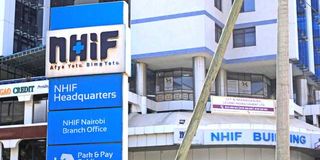Broke billionaires: Sad story of NHIF as millions suffer for it

The National Health Insurance Fund building in Nairobi. Hospitals that depend on NHIF to settle their bills are now operating in debt as funds from NHIF are yet to be released.
Health Cabinet Secretary Susan Nakhumicha yesterday said the National Treasury had finally released monies to the National Health Insurance Fund (NHIF), a day after she suggested the national insurer is struggling because ‘Kenya is broke.’ However, she but did not say how much money had been released, and to how many hospitals.
“Treasury released the funds this (Saturday) morning, when I was on my way here,” she said in Sabatia, Vihiga County.
When asked by journalists to explain, she replied: “Report on that first and allow us to give the figures when we return to the physical office.”
The CS also urged hospitals that have been turning away patients to resume normal services as the NHIF will soon begin processing claims.
NHIF Chief Executive Officer Samson Kuhora, when asked about the availability of the funds, said: “I am yet to confirm that from my team.”
Ms Nakhumicha had on Friday declared that Kenya is broke and that the national insurer will struggle for some time to stay afloat.
“Kenya is broke and that is the fact that no one can deny. The cash crisis has even affected NHIF. We are working on all available interventions to see how we will address the situation. One of the best solutions we are thinking about is the introduction of the Finance Bill 2023. That’s why our President is so passionate about it,” she said in an interview with a local radio station. She said that the National Treasury owes the Fund Sh20 billion.
The Rural Private Hospitals Association of Kenya (Rupha) and the Kenya Association of Private Hospitals (KAPH) had already announced that they would only accept cash payments from NHIF card holders after several attempts to engage the NHIF Board failed.
Hospitals that depend on NHIF to settle their bills are now operating in debt because, while the NHIF transactions had been approved, no funds had been released.
“It is really messy. The Fund owes us over Sh400 million from the last one year and they still expect us to continue offering services,” says a hospital administrator.
But the NHIF story is a case of a broke billionaire.
In January this year, NHIF had indicated that from its 15.4 million members, about 8.8 million had defaulted on monthly contributions, which really affected the operations of the Fund.
The data from the financial year that ended in June 2022 showed that dormant members hit 8.8 million from 5.03 million the year before, making the insurer miss its Sh90.57 billion targeted premium collections for the review period.
“The target was not achieved due to macro-economic factors in the country which caused companies to downsize, reduce salaries and some to close,” said NHIF in a health sector report made public by the Treasury.
“The informal sector has also faced financial challenges caused by the poor economic conditions thus making it difficult for members of this sector to make their voluntary contributions to the Fund.”
Voluntary contributors usually drawn from the informal sector pay Sh500 a month to the NHIF while those in the formal sector contribute between Sh150 and Sh1, 700 every month, depending on the salary scale.
The Fund indicated that the premiums collected rose by 30 per cent from Sh60.78 billion in the 2020/2021 financial year to Sh78.84 billion in 2021/2022.
The benefit payout to hospitals grew by 45 per cent from Sh49.04 billion to Sh71.34 billion.
The sharp rise in payouts was fueled by increased hospital visits unlike in the preceding period when many people avoided hospitals due to the fear of contracting the Covid-19 virus.
The cost of medical drugs and procedures, according to the Fund, has been on the increase in the wake of the shilling’s decline against the dollar, forcing healthcare providers to pass the increased cost to insurers and patients who pay out of pocket.
A financial report seen by Sunday Nation revealed that there has been revenue growth over the years, which means that the Fund has been making money.
The revenue grew from Sh31 billion in 2015/16 to Sh51 billion in 2017/18, mainly due to good coordination of both national and county governments on special schemes and premiums from private medical schemes.
Also, the membership growth was achieved by having counties sponsor vulnerable groups.
From the national scheme, the revenue grew from Sh28 billion to Sh31 billion in the same year. This was achieved through vigorous recruitment of members in the informal sector. From the managed scheme in the same year under review, the revenue increased from Sh3.5 billion to Sh16.2 billion.
The benefits paid out to hospitals grew from Sh5.6 billion in 2013/14 to Sh14.5 billion in 2015/16 to Sh36.7 billion in 2017/18.
According to an actuarial report on the NHIF released this year in April, the Fund missed out on Sh39 billion in premiums after 80 per cent of members drawn from the informal sector defaulted on monthly contributions, hence posing a sustainability threat to the public insurer.
The report revealed that just 1.6 million of the 8.1 million registered informal sector members were making the Sh500 monthly contributions, exposing millions of Kenyans to out-of-pocket medical bills. This means more than 80 per cent are in default.
The report, prepared by Kenbright Actuarial and Financial Services, says the voluntary contribution option is draining the NHIF since the majority of those keeping up with payments have chronic sicknesses, meaning they utilise the insurance coverage regularly.
According to the report, the situation is worrying since it is only the sick who are consistently paying the premiums, with many dropping off once they get the full benefit, which is rendering the scheme unsustainable.






